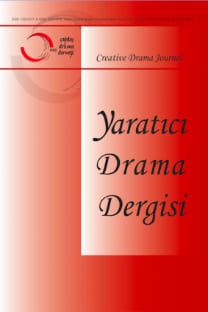Using Drama in English Classrooms: The Effects on Vocabulary Gains in Very Young Learners
Drama technique, Very Young Learners (VYLs), Vocabulary Gains, Teaching English to Very Young Learners (TEVYLs)
Using Drama in English Classrooms: The Effects on Vocabulary Gains in Very Young Learners
drama technique, Very Young Learners (VYLs), Vocabulary Gains, Teaching English to Very Young Learners (TEVYLs),
___
- Alqahtani, M. (2015). The importance of vocabulary in language learning and how to be taught. International Journal of Teaching and Education, 3(3), 21-34.
- Barnett, L. A. (1998). Educational drama and language arts: What research shows. Heinemann Drama.
- Boudreault, C. (2010). The benefits of using drama in the ESL/EFL classroom. The Internet TESL Journal, 16(1), 1-5.
- Boyatzis, R. E. (1998). Transforming qualitative information: Thematic analysis and code development. Sage Publications, Inc.
- Brown, A. (1993) Drama & short plays. Scholastic Publication Ltd.
- Kocaman, P., Dolmacı, M., & Bur, B. (2013). Identifying and comparing the attitudes of 1st, 2nd, 3rd and 4th grade ELT students towards drama activities. Uşak Üniversitesi Sosyal Bilimler Dergisi, Özel Sayı, 200-212.
- Chou, M. H. (2014). Assessing English vocabulary and enhancing young English as a foreign language (EFL) learners’ motivation through games, songs, and stories. Education 3-13, 42(3), 284-297.
- Clarke, V. & Braun, V. (2014) Thematic analysis. In T. Teo (Ed.). Encyclopedia of critical psychology (pp. 1947-1952). New York: Springer.
- Cremin, T., McDonald, R., Longley, E., & Blakemore, L. (2009). Jumpstart! Drama: Games and activities for ages 5-11. Routledge.
- Dal T. (2017) Knowledge and perceptions of EFL teachers about the use of drama techniques for promoting speaking skill: a diagnostic study (Master’s thesis). Uludağ University, Bursa, Turkey.
- Demircioğlu, Ş. (2010). Teaching English vocabulary to young learners via drama. Procedia-Social and Behavioral Sciences, 2(2), 439-443.
- Demircioğlu, S., & Ispir, O. A. (2016). The effect of creative drama as a method on teaching English word clusters. Yaratici Drama Dergisi, 11(1), 105.
- Dewey, J. (1993). How we think: A restatement of the relation of reflective thinking to the educative process. Boston: D. C. Heath. Edelenbos, P., Johnstone, R., & Kubanek, A. (2006). The main pedagogical principles underlying the teaching of languages to very young learners. European Commission, Education and Culture, Culture and Communication Multilingualism Policy. Retrieved from: https://www.smm.lt/uploads/documents/papildomas_ meniu1/ugdymas/uzsienio_kalbu_mokymas/EK%20ankstyvasis%20uzsienio%20klb.%20mokymas.pdf
- Fuentes, A. G. (2010). Break a leg! The use of drama in the teaching of English to young learners. A case study. Analizardatos Describirvariación [Recursoelectrónico]: Analysing data: Describing variation, 320-329. Gardner, H. (1999). The disciplined mind. New York: Simon & Schuster.
- Hapsari, H. D. (2015). Dramatization to teach English to young learners: A journey to implement the four Cs. Lia Research Journal, 8(1), 622-642.
- Haynes, J. (2007). Getting started with English language learners: How educators can meet the challenge. ASCD.
- Hazar, R. (2015). Using drama as a communication tool for young learners (Unpublished Master’s thesis). Çağ University, Mersin,Turkey. Heathcote, D., & Bolton, G. (1994). Drama for learning: Dorothy Heathcote’s mantle of the expert approach to education. Dimensions of drama series. Heinemann, 361 Hanover St., Portsmouth, NH 03801-3912.
- Heinig, R. B. (1993). Creative drama for the classroom teacher. Englewood Cliffs: Prentice-Hall.
- Kırkgöz, Y. (2007). English language teaching in Turkey: Policy changes and their implementations. RELC journal, 38(2), 216-228.
- McHugh, M. L. (2012). Interrater reliability: The kappa statistic. Biochemia Medica, 22(3), 276–82. doi:10.11613/BM.2012.031
- Pinter, A. (2017). Teaching young language learners. Oxford University Press.
- Rew, S., & Moon, Y. I. (2013). The effects of using English drama on the learning of target expressions for primary school students. The Journal of Asia TEFL, 10(4), 215-239.
- Rui, W. (2017). Using drama activities in teaching English to young learners in China. DEStech Transactions on Social Science, Education and Human Science, 3,42-26.
- Shin, J. K. (2006). Ten helpful ideas for teaching English to young learners. In English Teaching Forum (Vol. 44, No. 2, p. 2). US Department of State. Bureau of Educational and Cultural Affairs, Office of English Language Programs, SA-5, 2200 C Street NW 4th Floor, Washington, DC 20037.
- Stewing, J. W & Buege C. (1994) Dramatizing literature in whole language classrooms. New York: Teachers College Press.
- Üstündağ, T. (1997). The advantages of using drama as a method of education in elementary schools. Hacettepe Üniversitesi Eğitim Fakültesi Dergisi, 13, 11-13.
- Warren, A. N. (2013). Teaching EFL to young learners. 6th Annual English Language.
- Wessels, C. (1987). Drama (Vol. 3). Oxford. Oxford University Press.
- Wilkins, D. A. (1972). Linguistics in language teaching. E. Arnold, 1973. p.111.
- Yılmaz, R. (2010). An Investigation into the effects of creative drama activities on young learners’ vocabulary acquisition: A case study (Unpublished Master’s thesis). Gaziantep University, Gaziantep, Turkey.
- Yin, R. K. (2009) Case study research: Design and methods. SAGE Publications Ltd: London.
- Zafeiriadou, N. (2009). Drama in language teaching: A challenge for creative development. Issues, 23, 4–9
- ISSN: 1305-8177
- Yayın Aralığı: 1
- Başlangıç: 2006
- Yayıncı: Gençlik Kulübu ve Çağdaş Drama Derneği
Harriet Finlay-Johnson’ın Drama Yaklaşımı
Gülendam AKGÜL, Derya ATALAN-ERGİN, Sıla UZUNPINAR
Müzelere Yönelik Yaratıcı Drama Projelerinin İncelenmesi
Gizem SİVRİOĞLU, Gökhan KARAOSMANOĞLU
Using Drama in English Classrooms: The Effects on Vocabulary Gains in Very Young Learners
Sosyal Bilgiler Öğretiminde Yaratıcı Drama Yönteminin Kullanılmasına İlişkin Öğrenci Görüşleri
